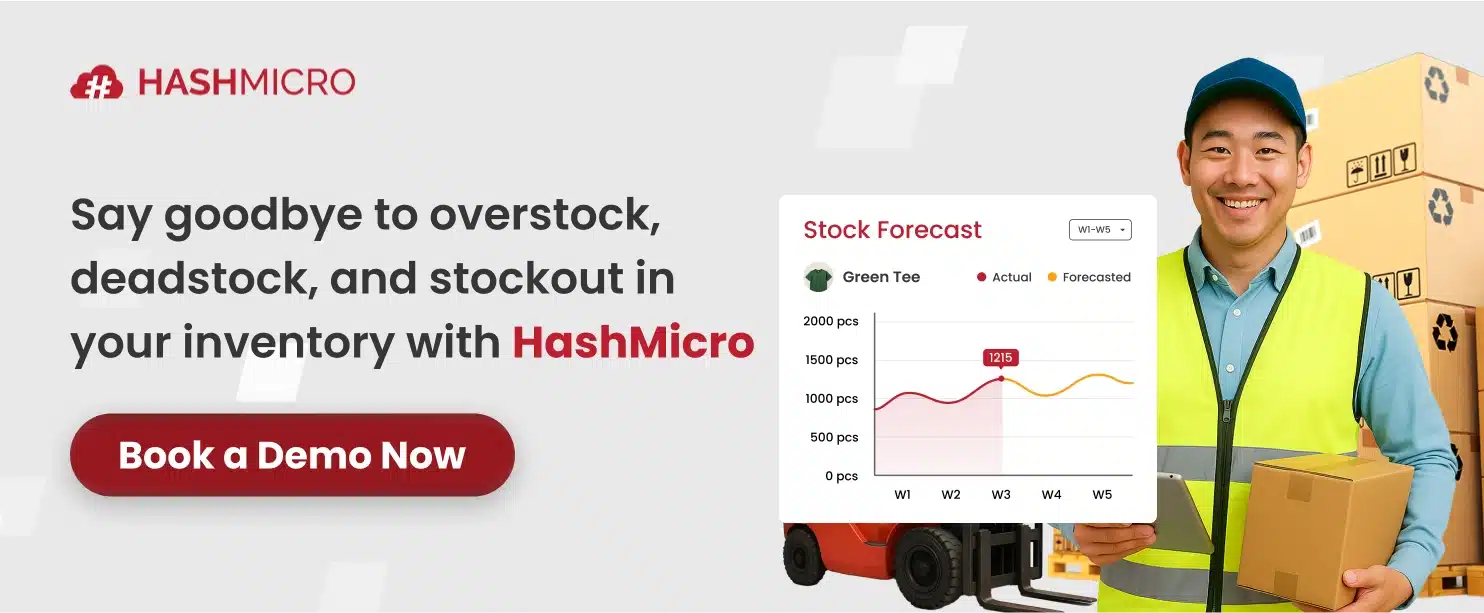Inventory holding costs are the expenses I incur from storing unsold goods, including warehousing, insurance, and opportunity costs. These costs can build up over time and directly impact my business’s profitability if not managed effectively.
When I fail to control holding costs, they can strain my resources by tying up capital in unsold inventory, ultimately increasing operating expenses. That’s why understanding and managing these costs is crucial to maintaining a healthy cash flow and ensuring smoother business operations.
In this article, I’ll share a complete guide on what inventory holding costs are and how I manage them effectively. If you want to optimize your inventory management and reduce operational expenses, try HashMicro’s free demo today and see how automation can simplify cost control.
Key Takeaways
|
What Are Inventory Holding Costs?
Inventory holding costs, or carrying costs, are expenses related to storing unsold goods, including warehousing, insurance, and opportunity costs. These costs accumulate over time and impact profitability by tying up capital and resources that could be better utilized elsewhere.
Therefore, managing inventory holding costs is crucial for profitability, as excessive inventory increases expenses and wastes resources. By optimizing inventory levels, businesses can reduce these costs, improve cash flow, and allocate capital more efficiently.
Where Companies Typically Face Holding Costs?
Companies typically face holding costs wherever their inventory is stored, whether in warehouses, storage units, or fulfilment centres. As businesses scale, these costs increase with the need for larger spaces, specialized storage, and third-party logistics support.
Companies face holding costs in three main areas as their operations expand:
- Warehouses
When businesses lease, buy, or build warehouses to store inventory, they incur expenses such as rent, utilities, maintenance, and specialized storage (e.g., temperature control). These costs rise with the size and complexity of the facility. - Storage units or facilities
As inventory outgrows home or office space, companies often rent smaller, temporary storage units. While more affordable than full warehouses, these still generate holding costs through rental fees and limited access efficiency. - Fulfillment centers (3PL providers)
Businesses partnering with third-party logistics providers face holding costs as part of broader fulfillment fees. These centers store products, pick and pack orders, and handle shipping—combining storage expenses with operational costs.
Inventory Holding Costs Examples
Understanding inventory holding costs is essential, but it’s equally important to recognize the specific examples contributing to these expenses. Here are some examples of inventory holding costs:
- Storage fees: These include the costs of renting or maintaining a warehouse to store unsold goods. This also covers utilities and security measures.
- Insurance premiums: Businesses often insure their inventory against risks such as theft, fire, or natural disasters, leading to regular insurance costs.
- Cost of capital: This cost refers to the opportunity cost of having money tied up in inventory that could otherwise be invested in other business areas.
- Inventory shrinkage: This includes losses due to theft, damage, or spoilage, which can occur during storage or handling.
- Obsolescence costs: As products age, they may become obsolete. This results in potential losses if the items can no longer be sold at full price or at all.
- Depreciation: Over time, the value of inventory might decrease, particularly with perishable goods or products with a short life cycle.
How to Calculate Inventory Holding Costs

Understanding that holding costs represent a significant portion of your overall inventory expenses is essential. Correctly calculating and managing these costs is crucial for maintaining a healthy bottom line. Let’s break down the steps involved in calculating inventory holding costs.
To calculate your inventory holding costs, you can use the carrying costs formula:
Inventory Holding Cost (%) = (Total Inventory Costs / Total Inventory Value) x 100
After understanding the formula for calculating inventory holding costs, it’s important to break down the process into clear, manageable steps. Here’s how to calculate your inventory holding costs step by step:
1. Sum up total inventory costs
Start by identifying and adding up all the costs of holding your inventory. These include:
- Capital costs: The money spent purchasing raw materials or inventory, including any associated financing fees and taxes.
- Warehouse costs: Expenses incurred for storing unsold inventory, such as rent, utilities, and insurance for your storage space.
- Employee costs: The employment cost index, which tracks labor cost changes, influences the salary, wages, and benefits of warehouse personnel.
- Opportunity costs: The potential revenue lost by storing unsellable inventory instead of faster-moving items or missing out on new opportunities due to cash being tied up.
- Depreciation costs: These costs include the decrease in value of products over time as they sit in storage.
- Inventory risk costs: Expenses related to losses from theft, damage, or product obsolescence before the inventory is sold.
2. Calculate the total inventory value
To find the total inventory value, calculate the average value of the inventory you had on hand during your measuring period. This is done by dividing the number of units sold by the average number of units on hand:
Total Inventory Value = Number of Units Sold / Average Number of Units on Hand
This calculation gives you an estimate of the total value of your inventory during the time frame you’re examining. It’s a crucial step because the holding cost percentage is based on how much your inventory is worth at any given time.
3. Determine inventory holding costs percentage
The final step is to determine the inventory holding cost percentage. This is done by dividing the total inventory costs by the total inventory value, then multiplying by 100 to express it as a percentage:
Inventory Holding Cost (%) = (Total Inventory Costs / Total Inventory Value) x 100
This percentage tells you what portion of your inventory’s value is consumed by holding costs. Understanding this figure is essential because it helps you assess the financial impact of storing goods and effectively guides decisions on managing and reducing these costs.
Strategies to Reduce Holding Costs
Reducing inventory holding costs is essential for maintaining efficiency and profitability. Implementing targeted strategies can help businesses cut unnecessary expenses and optimize operations. Here are some practical ways to manage and lower these costs:
1. Leverage Just-in-Time (JIT) inventory
Implementing Just-In-Time (JIT) inventory management reduces overstock by ordering goods only when needed. As a result, holding costs are kept to a minimum, and inventory expenses are reduced. Businesses adopting this strategy can better manage cash flow and optimize inventory control management to meet customer demand.
2. Leverage 3PL services
Partner with a third-party logistics provider (3PL) to significantly reduce storage and labor expenses. Outsourcing storage to 3PL minimizes the burden of managing large warehouses. Additionally, integrating logistic management software streamlines these processes, effectively keeping inventory holding costs under control.
3. Optimize warehouse layout and processes
Optimizing your warehouse layout ensures you store inventory to minimize handling time and maximize storage space. Enhancing warehouse processes, such as upgrading shelving systems or implementing automation, leads to cost savings. Efficient processes also reduce errors, minimizing unnecessary inventory expenses.
4. Adjust reorder points and quantities
Regularly reviewing and adjusting reorder points based on demand forecasts can prevent overstock and higher holding costs. Setting optimal reorder quantities ensures you order just enough to meet demand, avoiding extra storage and handling costs. This approach supports better inventory turnover and reduces the financial burden of unsold goods.
5. Regularly audit inventory
Conducting regular inventory audits helps identify slow-moving or obsolete items that contribute to higher inventory holding costs. Audits also provide insight into inventory expenses, allowing you to adjust your purchasing strategies. This proactive approach ensures that holding costs are minimized and storage is optimized for more profitable items.
6. Implement inventory management software
Inventory management software automates tracking and managing inventory levels, reducing the risk of overstock or stockouts. Integrating cloud based inventory solutions enhances accessibility, allowing businesses to track stock levels anytime, anywhere, and streamline operations across multiple locations.
7 Tips to Reduce Holding Costs
Reducing holding costs is essential to maintaining profitability and ensuring efficient inventory management. Here are seven practical tips to help you minimize these expenses and improve your cash flow.
- Optimize inventory levels
Holding too much stock can drain your capital and inflate storage expenses. Start by calculating safety stock levels, economic order quantities (EOQ), and reorder points for each SKU. Use demand forecasting and inventory management software to maintain ideal stock levels that meet customer demand without overstocking. - Eliminate dead stock
Obsolete or unsellable inventory adds unnecessary storage costs. Clear out dead stock through discounts, product bundles, or donations for tax deductions. Regularly reviewing your inventory ensures that shelf space is reserved for items that generate profit, not losses. - Improve inventory turnover
A faster inventory turnover means lower holding costs. Focus on high-demand products and purchase smaller quantities more frequently. When sales slow, stimulate movement with limited-time promotions or bundle deals to prevent excess stock from sitting idle. - Maximize warehouse efficiency
Inefficient warehouse layouts can increase storage expenses. Redesign your warehouse with space-efficient racking systems and streamlined picking routes. Consider outsourcing to logistics providers with optimized storage facilities to reduce overhead and enhance order fulfillment. - Automate inventory management
Manual errors can lead to overstocking or missed reorder points. Automating warehouse operations helps track inventory in real time, sends reorder alerts, and optimizes picking routes. Investing in an advanced IMS or WMS boosts accuracy, efficiency, and cost savings. - Partner with a 3PL provider
Third-party logistics (3PL) providers offer scalable storage and fulfillment solutions that reduce the burden of managing your own warehouse. They often include logistics management software, data analytics, and integration tools to improve visibility and control over inventory holding costs. - Adopt the Just-In-Time (JIT) approach
Implementing JIT inventory management helps you order goods only when needed, minimizing overstock and storage time. This strategy keeps holding costs low while ensuring you always have the right amount of stock to meet customer demand.
Optimize Your Inventory Management with HashMicro

Inventory Management Software is a robust ERP solution for streamlining and optimizing inventory levels. It automates inventory tracking, demand forecasting, and supplier coordination to reduce holding costs and improve operational efficiency.
HashMicro offers a free product tour and consultation to help businesses understand how the software can be tailored to their needs. This approach ensures companies can effectively implement the system, resulting in better inventory management and significant cost savings.
Features:
- Stock forecasting
HashMicro’s stock forecasting feature uses advanced algorithms to accurately predict future demand, helping businesses avoid overstock and reduce holding costs. Analyzing historical data ensures optimal inventory levels, minimizes storage expenses, and improves cash flow.
- RFID warehouse rack stock in & out automation
The RFID warehouse rack stock in & out automation feature streamlines inventory tracking by automatically recording stock movements. This reduces manual errors and speeds up inventory processes, leading to lower labor costs and more efficient use of storage space.
- OCR (Optical Character Recognition) for receiving
HashMicro’s OCR for receiving feature automates the data entry process when goods are received. Scanning and digitizing documents ensures accuracy and speeds up inventory updates, reducing the time and costs associated with manual data entry.
- Stock optimizer per warehouse
The stock optimizer per warehouse feature ensures that each warehouse maintains the proper inventory levels based on specific demand. This optimization reduces overstock and minimizes holding costs by aligning stock levels with actual needs across multiple locations.
- Quality control management
This feature helps maintain product standards by identifying and addressing quality issues early. Additionally, integrating quality checks into the inventory process prevents defective goods from accumulating, thereby reducing unnecessary inventory expenses.
- Return management
This feature streamlines the handling of returned goods, ensuring they are processed efficiently. This reduces the space and costs of holding returned items and helps maintain accurate inventory records.
- Stock reservations & reporting
HashMicro’s software allows businesses to allocate inventory for future orders while providing detailed reports. Consequently, this feature helps manage stock levels proactively, prevent overstock, and reduce overall holding costs.
Finding the right fit for your budget is essential to elevating your business with HashMicro’s advanced solutions. Click the banner below to explore the pricing schemes and discover the plan that best aligns with your business needs.
“Inventory holding costs go beyond storage expenses. They tie up capital and reduce agility. By minimizing these costs, businesses can boost cash flow and operational efficiency.”
— Angela Tan, Regional Manager
Conclusion
Effective inventory management is essential to reducing holding costs and improving profitability. Leveraging inventory management software can streamline processes, optimize stock levels, and prevent costly overstock situations.
HashMicro Inventory Management Software offers a comprehensive solution designed to help businesses minimize holding costs. Features like stock forecasting and automated tracking ensure your inventory is always aligned with market demand.
Take the next step toward better inventory management by implementing HashMicro’s software. Sign up for a free demo today to see how it can improve your business’s efficiency.
Frequently Asked Questions About Inventory Holding Costs
-
Is inventory carrying cost part of COGS?
No, inventory carrying cost is not part of the Cost of Goods Sold (COGS). COGS represents the direct expenses related to producing and selling goods, such as the cost of raw materials, direct labor, and manufacturing overhead.
On the other hand, inventory carrying cost refers to the expenses incurred for holding and storing unsold inventory. While COGS is recorded as an expense on the income statement, inventory-carrying costs are considered operational expenses and are recorded separately.
-
What is the difference between inventory cost and holding cost?
Inventory cost is a broad term that includes all costs associated with acquiring and producing goods. This consists of the purchase price of raw materials, labor costs, and any overheads needed to manufacture goods that will be added to inventory.
Holding cost, or carrying cost, is a specific subset of inventory cost that focuses on the expenses related to storing and maintaining inventory over time. While inventory cost covers the overall expenditures from acquisition to production, holding cost deals explicitly with the costs incurred from keeping inventory until it is sold.
-
What are the causes of inventory carrying costs?
Inventory carrying costs stem from various factors related to storing and managing inventory. Key contributors include storage expenses, such as warehousing and utilities, insurance against risks like theft or damage, and depreciation as inventory loses value over time.
Spoilage affects perishable goods, while opportunity costs arise from capital tied up in inventory. Additional factors include property taxes and financing costs. Effectively managing these elements is essential for minimizing holding costs and boosting business efficiency.















